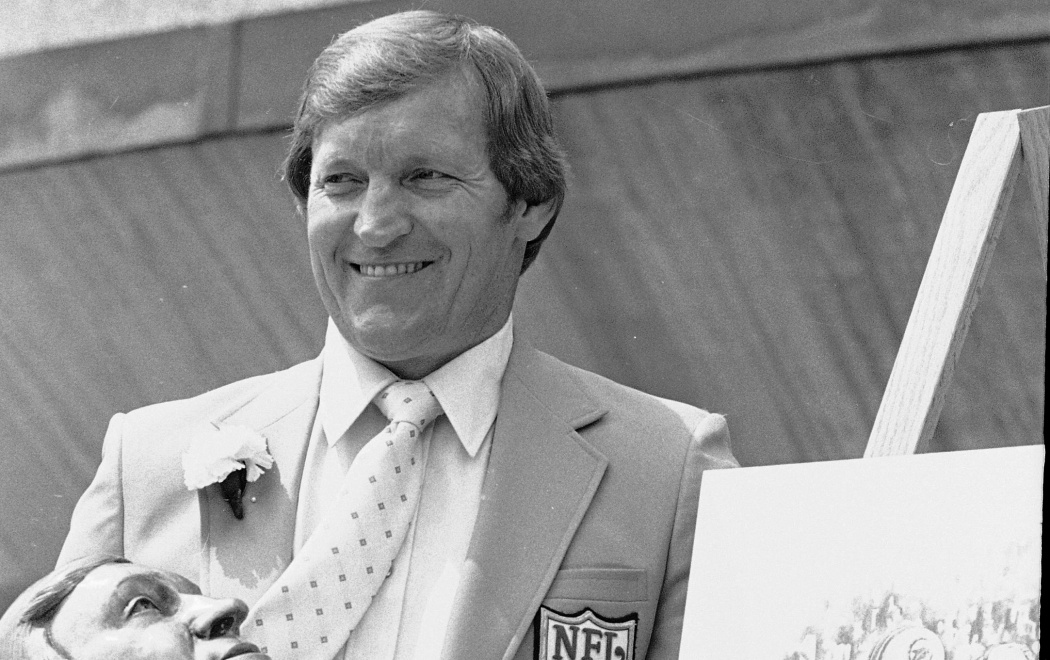Gold Jacket Spotlight: Jim Otto's Pain & Glory

Grasping life’s highs and lows for Jim Otto – his excellence on the football field and the lifelong physical toll achieving that excellence extracted – requires little more than reading the first few pages of his aptly titled autobiography, “The Pain of Glory.”
Both the pain and the glory are relived this week as Jim, a member of the Pro Football Hall of Fame’s Class of 1980, steps into the Gold Jacket Spotlight.
In the first sentence of his foreword for the book, Hall of Fame coach John Madden writes: “If someone came from another planet and wanted to know what a football player looked like, you’d show him a poster of Jim Otto.” Madden goes on to call Jim “the greatest center who ever played.”
Numerous accolades for Jim support Madden’s widely shared opinion of the 15-year pro as the best to play his position: 10 first-team All-Pro selections, 12 Pro Bowl appearances and spots on the AFL Hall of Fame All-1960s Team and the NFL 100 All-Time Team.
One of pro football’s legendary ironmen, Jim played in 210 consecutive regular-season games – from his rookie-season opener to the final game of his last season. Counting preseason, postseason and Pro Bowl games, that number swells to 308 consecutive games played, with rarely a missed practice, either.
All that action in the trenches – nearly every offensive and special teams snap for a decade and a half – came with a high price, however.
In the opening chapter of his autobiography, Jim provides an accounting: 38 surgeries (a total now estimated to have doubled since the book’s 2000 publishing date), including 28 on his knees alone, both of which are artificial, as are both shoulders. He waited six months between artificial knees 5 and 6 after fighting off an infection that nearly took his life. He counts three near-death experiences directly related to infections or septic shock from football-related surgeries.
He considered the 20-some broken noses as more nuisance than hindrance, along with a hip pointer, broken fingers, broken ribs, a broken jaw, neck stingers, numerous concussions, kicked-in teeth and a bout of double pneumonia.
“Minor injuries, therefore minor distractions,” he called them. “I was paid to play football, not hang out in the training room.”
“Mr. Raider” played … and played … and played – constantly proving wrong several coaches who in high school, college and the pros considered him undersized to hold up against defensive linemen and linebackers.
Some things couldn’t be measured, however, like Jim’s self-motivation, commitment and pride.
“I played football because I loved the game, and I did everything I could to win, and people knew that,” Jim said. “I wanted people to respect me.”
The only first-team All-AFL center in the league’s 10-year history, Jim helped the Raiders rise from a 9-33 start in their first three years of existence to a team that won seven division titles and an AFL title and made a Super Bowl appearance before he retired.
Even as the surgeries mounted and routine elements of daily living became more and more challenging – “Waking up is the best part of my day,” he wrote – Jim has repeated in many interviews since his retirement that we wouldn’t change history.
“Football has given me so many memories that money can’t buy,” he said. “That’s why I think I’d come back and do it again.”
While an encore performance on the field isn’t possible, Jim’s glorious playing career can be appreciated again this week in the Gold Jacket Spotlight.
The Mission featuring Rod Graves, Executive Director of the Fritz Pollard Alliance
Graves’ experience spans over 37 years as a football administrator of the NFL.
Sarah Thomas Makes Officiating History
The Pro Football Hall of Fame recently received new artifacts from Super Bowl LV.

